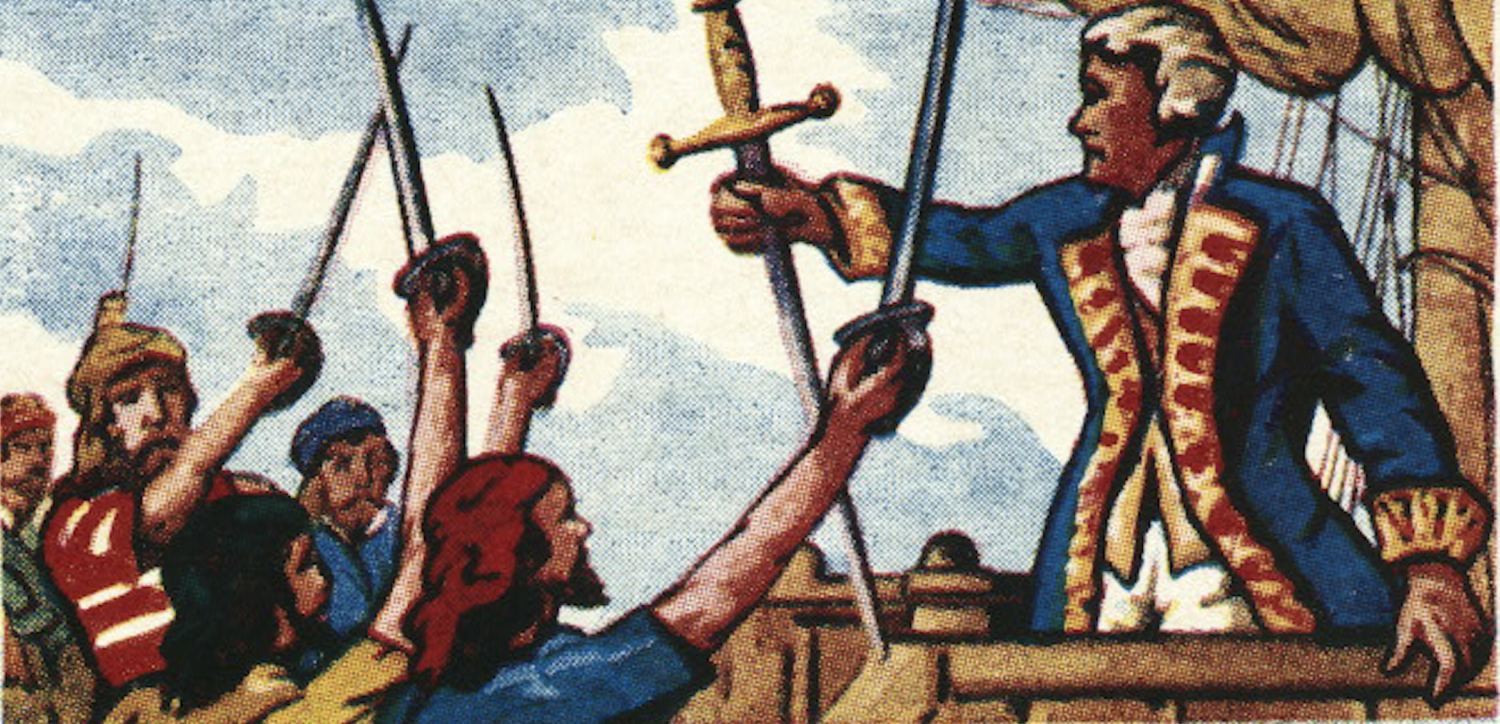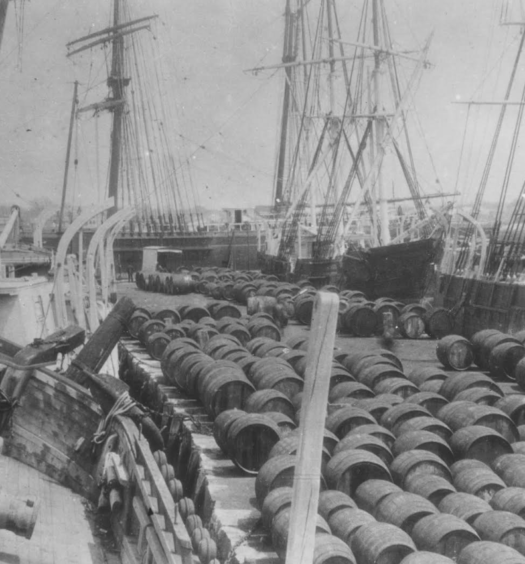Contrary to the popular image of Johnny Depp’s Jack Sparrow character as an amiable buffoon, pirates in their day were usually cruel thugs, petty criminals, and international terrorists. Pirates had an easy relationship with colonial Rhode Island because the colony’s elected governor would frequently grant privateering commissions in exchange for large fees paid personally to the governor, with few questions asked.
The end of that practice was approaching in the 1720s when cruel pirate Captain Francis Spriggs, an associate of the notorious pirate Captain Ned Low, captured a Rhode Island merchant ship at sea. One of Rhode Island’s biggest colonial industries was the breeding of Narragansett Pacers in South County. Pacers were horses specially bred to “pace” rather than trot, with a smooth rather than bouncy gait, most suited for carrying plantation overseers and slave supervisors in comfort on their necessary all-day rides. Therefore, these unique horses were widely exported to Caribbean plantations. Spriggs captured a ship full of Pacers destined for sugar plantations near Paramaribo, Suriname, and his men amused themselves trying to race the poor horses around the deck before throwing them into the sea. Spriggs and his men avoided capture that time, and actually visited Rhode Island with impunity at a later date, but in 1723 twenty-six other pirates were rounded up and publicly hanged at Gravelly Point in Newport where Newport Shipyard now stands. That event marked the official end of piracy in Rhode Island, at more or less the same time that it was ending elsewhere in the Europeanized world.
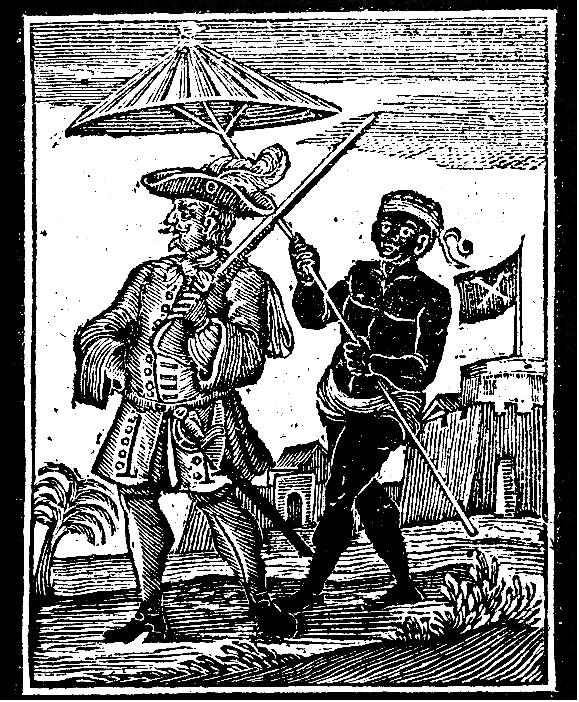
This woodcut of the pirate Henry Every being escorted by an African shows what may be the fort at Port Misson in the background (Wikipedia)
On the other hand, for some reason, a few earlier pirates stand out as being somewhat less thuggish. Take, for example, the mostly-college-graduate crew of about sixty young men of the 14-gun corvette Batchelors Delight in the 1680s. They won their ship in a card-game and sailed around Cape Horn, where they parked themselves off the coast of Chile in order to pillage unarmed Spanish merchant ships carrying quantities of Bolivian silver, gold and jewels from Chile to Panama. A hastily assembled naval force drove them west, where they managed to be the first Europeans to see the east coast of New Zealand. They continued their treasure hunting from the Galapagos Islands until they could see that the ship could not safely sail home, because of the weight of all the gold! After burying a third of their treasure on a remote island, they sailed back to the Atlantic, becoming the first people in the history of the world to see part of Antarctica along the way. In order that they not be arrested for piracy, Captain Davis agreed to deposit four crewmen plus shares of the treasure in each of the American colonies. I have not so far discovered the identities of the four crewmen who settled in Rhode Island in 1687, or what happened to them subsequently. Does anyone know?
The four who settled in Virginia were talked into putting up half their treasure (about $13 million in today’s money) for the founding of the College of William & Mary at Williamsburg in 1693. Then the ship’s surgeon, Lionel Wafer of Scotland, persuaded the Scots to found their first colony, Caledonia, in a part of Spanish Panama. The subsequent collapse of the colony and the resulting financial disaster was a factor forcing then-independent Scotland to join with England in the Union of Great Britain in 1707.
[Full disclosure: I, who previously built the full-sized operational copies of the Revolutionary War ships Rose and Providence, am now raising money for a tax-exempt corporation, Colonial Navy Inc., to build a copy of the Batchelors Delight for a year-round sail-training program. A direct descendant of Captain Edward Davis has already made a generous donation. Is anyone interested in helping?]Two Rhode Island pirates also seem to have led less thuggish lives than most, and they may even have known each other in Newport. William/Guillaume Mayes Jr. of Newport, born in Provence, France about 1662, used a series of aliases, including May, Mason (instead of the modern usage of Mayes, Jr. he called himself Mayes’ Son, = Mason), Misson, (Misson is obviously the French mispronunciation of Mason), and even Mission, and he used different first-names of James and Olivier, as well as William. I will call him by his Newport name, William Mayes.
Mayes’s Huguenot family moved to Newport, as quite a few other Huguenot families did, when he was a boy, because they could see that Louis XIV was planning to revoke the Edict of Nantes, which guaranteed equal rights for French Protestants, and which in fact was revoked in 1685. Mayes enrolled at age 15 at the ancient University of Angers (on the Loire River, just inland from the seaports of Saint-Nazaire and Nantes), but dropped out after one year. His family tried to persuade him to join Louis XIV’s Musketeers, but he thought that a career in the navy would be more fun. Later, he found himself as a lieutenant in the crew of a French Naval corvette of about 18 guns called La Victoire, measuring about 100 feet long on deck, rather low to the water, and therefore wet, but fast; she was a little smaller than the frigate Rose, and considerably lower. The ship was participating in what became known as the Nine Years’ War, which was essentially Louis XIV against all the rest of Europe. While the ship was on a visit to Italy, Mayes made friends with a former Dominican priest called Caraccioli, who had some radical ideas, and he talked him into joining the crew. A few months later, they fought against a more powerful British ship off the coast of Martinique. The British ship blew up with no survivors, but La Victoire’s Captain Fourbain (a cousin of Mayes) died of his wounds.
With Mayes being the senior surviving officer, the crew of almost 200 men decided that rather than report to naval authorities in Martinique they wanted to turn her into a pirate ship with Mayes as their new captain. Sailing across the Atlantic Ocean, near the coast of Ghana, they captured the Dutch ship Nieuwstadt with some gold in the cargo, and then Mayes took them around the Cape of Good Hope to the Indian Ocean, where they captured various Arab and European ships loaded with treasure and with slaves. Mayes, who did not believe in slavery, insisted that any slaves they captured be given their freedom, and any sailors they captured had to be treated with respect. They became embroiled in a local war on Johanna Island in the Comoros Islands, between the north end of Madagascar and Malawi; they won the engagement, but Caraccioli was seriously wounded by a stab in the ribs. They then captured a Portuguese ship with more gold aboard, but Caraccioli had to have one leg amputated from wounds he received there.
Mayes found a portion of the coast of the island of Madagascar from Antongil Bay, also called Ranter Bay or Rantabe, in the northeast plus Saint Mary’s Island (modern name: Nosy Boraha) and several miles farther down the coast suitable for settlement (this is the area where the majority of the world’s vanilla is still grown). Their territory definitely went as far south as Mahavelona (or Foulpointe, as the pirates called it), about one-third of the way down the east coast, and may even have gone as far as Mananjary, in the county of Fianarantsoa, about two-thirds of the way down the coast. There Mayes and his crew founded in the late 1680s the Republic of Libertatia (another spelling was Libertalia), which was necessarily confined to a ribbon of land along the coast.
Mayes was somewhat familiar with the exceptionally liberal Rhode Island Charter issued by Charles II in 1662. Mayes may also have heard later about the 1689 English Bill of Rights, another liberal document that influenced the writing of the United States Bill of Rights of a century later. With these documents as models, added to Caraccioli’s progressive ideas, their somewhat anarchic republic may have been the world’s first fully democratic entity. Slavery was completely outlawed in Libertatia. The new republic was operated by the votes of all its adult residents of all races and languages (including the slaves they had freed and quite a few native residents and apparently of women as well). The chief executive was known as the Lord Conservator, elected for a term of three years. Mayes was the first to be elected.
One of the republic’s towns, located on Saint Mary’s Island, was called Port Misson (Mayes was called Misson then). A woodcut of pirate Henry Every shows what may be the fort at Port Misson, and the architecture appears surprisingly formal, a match to buildings designed by English architect Elizabeth Wilbraham in Bombay, Calcutta, and Madras in India in the same time period; no sign of that fort survives today. All the republic needed at the time were additional citizens. In contrast to black or occasionally red pirate flags, the Libertatia flag was white.
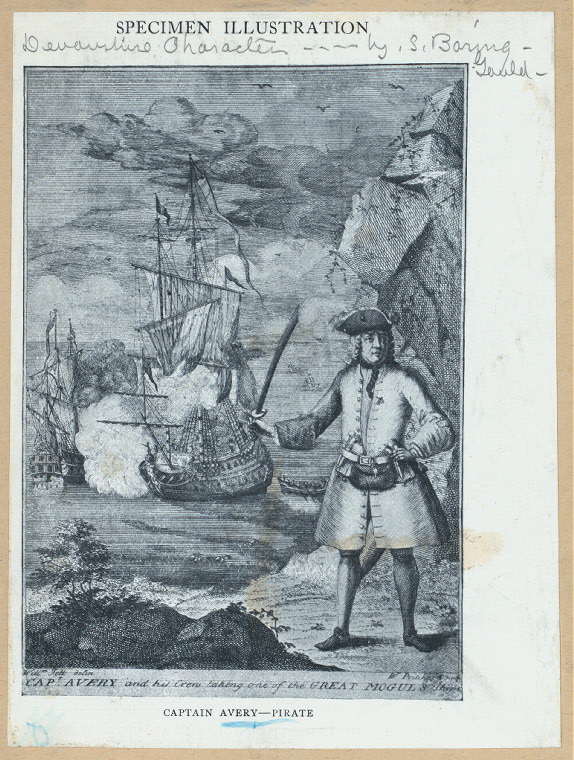
This portrait of Henry “Long Ben” Every (or Avory or Avery) shows him standing with an accurate depiction of the 46-gun ship Fancy in the background. He made a generous contribution to Mayes for supplies for Libertatia (New York Public Library)
Daniel Defoe wrote about Caraccioli:
He fell upon Government, and shew’d that every Man was born free, and had as much Right to what would support him as to the Air he respired… that the vast Difference betwixt Man and Man, the one wallowing in Luxury, and the other in the most pinching Necessity, was owing only to Avarice and Ambition on the one hand, and a pusillanimous Subjection on the other.
Mayes/Misson must have trusted Caraccioli to run the republic well, because his own first act was to sail back to Jamaica in order to pick up a privateer’s commission from the governor there (who was apparently less greedy for heavy privateers’ license fees than Governor Cranston of Rhode Island). Until his death in 1688, the Jamaica governor was Sir Henry Morgan, himself a man with an infamous buccaneering past, but he had established in Jamaica a climate of tolerance for privateers. On the return voyage to Libertatia in command of the full-rigged ship Jacob (like La Victoire, about 100 feet long on deck with perhaps 16 guns, but higher out of the water and a little slower), Mayes stopped briefly in Rhode Island, probably to see his family and to pick up additional crew. On the voyage from Jamaica to Newport, he transported James Kelley, former crew-member of the Batchelors Delight, but Kelley, who also held a privateer’s commission from the governor of Jamaica, secured another commission from Cranston as insurance, purchased his own sloop Diamond at Newport, and sailed her to Madagascar, where he was amazed to find his old ship Batchelors Delight at anchor. He promptly sold his sloop and took the job as quartermaster (second in command) on his former ship; a few weeks later, he was promoted to captain. Shortly after that, Captain Edward Davis, the former captain of Batchelors Delight during her adventures on the west coast of South America, also arrived at Madagascar and was equally surprised to see his old ship commanded by his old shipmate Kelley. All the officers’ positions being already taken, he contented himself with signing on aboard her as a common seaman for a time.
At the same time as the founding of Libertatia, New Yorker Adam Baldridge had set himself up as king of his part of Saint Mary’s Island, which is about 25 miles long and two miles wide. He was forced to flee back to New York in 1697. His place was taken by the ineffectual Edward Welsh for a short time, and he in turn was relieved by Dutch pirate Jan Pro until his death in 1719. It is not clear how such an entity could have coexisted with Libertatia on the same island; perhaps the Baldridge kingship extended to only one town on the island. Baldridge’s town was a magnet for pirates.
Abraham Samuel, a mulatto from America, arrived in 1697 at Fort-Dauphin (modern name: Taolagnaro) at the southern point of Madagascar aboard Captain John Hoar’s Rhode Island pirate ship John & Rebecca. The local widowed queen was amazed to see Samuel, and she identified him as her long lost son, so he was made King Samuel of the small Fort-Dauphin region until his death in 1705. Regional kingships of that sort in Madagascar were apparently not unusual.
In 1689, Mayes was back in the Caribbean, where he joined the crew of Captain William Kidd’s 20-gun ship Blessed William. Soon afterwards, the crew decided to maroon Kidd on a beach while they sailed off and elected Mayes as their new captain. Kidd never forgave Mayes, and when Kidd was appointed in charge of an expedition to root out Indian Ocean pirates, he made sure that Mayes’s name was specifically mentioned in the document. Mayes, meanwhile, had sailed to New York, where he bought an anti-French privateer’s commission from the venal Governor Fletcher before returning to Libertatia.
Not long after the founding of Libertatia, Thomas Tew of Newport (born about 1663) appeared. Tew (then pronounced “Toe”) had grown bored in Newport, so he sailed as captain on a licensed privateer 12-gun sloop called Amity, about 65 feet long on deck, from Bermuda in 1691 (looking much the same as the sloop Providence of eighty-five years later, but built of long-lasting Bermuda red cedar/juniper). The idea was for Amity and another sloop to attack French settlements in Senegal because England and France were in a war at that moment. After their voyage had been hindered by a bad storm and the two sloops separated at sea, the crew of about sixty men said they would rather forget the plan to attack Senegal, sail to the Indian Ocean and the Red Sea, and go a-pirating.
Tew therefore sailed them there, where they captured a rich Arab trading ship, netting each sailor over 3,000 pounds sterling. At that point, twenty-four of his crew asked to be dropped off on the coast of Madagascar with their share of the treasure while the rest of the crew sailed home.
Only a few miles into their trip back to Rhode Island, they spotted the ship La Victoire and her Portuguese prize, so they gave chase. They raised the Black Flag and fired one gun in the other direction, the usual signal for demanding a surrender, but the other ship also raised the Black Flag and fired a single gun in the other direction. The two ships therefore got together, and Tew was delighted to find Mayes with Newport connections as the other ship’s captain. Mayes showed Tew what he had started building for his new republic, including some forts, some fine public buildings, and streets of neat houses. He asked for Tew’s help to secure resources and additional citizens.
Tew sailed on several short voyages to do just that, and then he sailed for four months along the coasts of Madagascar on the borrowed sloop Liberty making maps and charts of the entire large island, which had not previously been available, even to European navies. He next returned to Newport making the initial investors in his voyage wealthy beyond their dreams. He talked up the idea of Libertatia among Newporters, but there is no record of how many new settlers he was able to secure. At great expense, he bought himself a new privateer’s commission from Rhode Island Governor Samuel Cranston, and sailed back to Libertatia.
Mayes then gave him command of La Victoire and ordered him to find more citizens to populate the republic. He first went ashore to talk to the twenty-four former crewmembers who had asked to be put ashore during the previous voyage, but suddenly the weather turned bad. La Victoire dragged her anchors and was driven on a reef by an unexpected hurricane with the loss of nearly all her crew. Meanwhile, back at the republic, a fierce warlike tribe from the interior had attacked without warning. Many citizens, men, women, and children of all races, including Caraccioli, were butchered. Mayes sailed along the coast until he found Tew, and each shared the stories of their respective disastrous misfortunes. They decided to sail together in separate sloops back to Newport, leaving the remaining citizens of the republic temporarily to fend for themselves. Their plan was to talk up the republic in Newport and see how many people would want to sail to Libertatia.
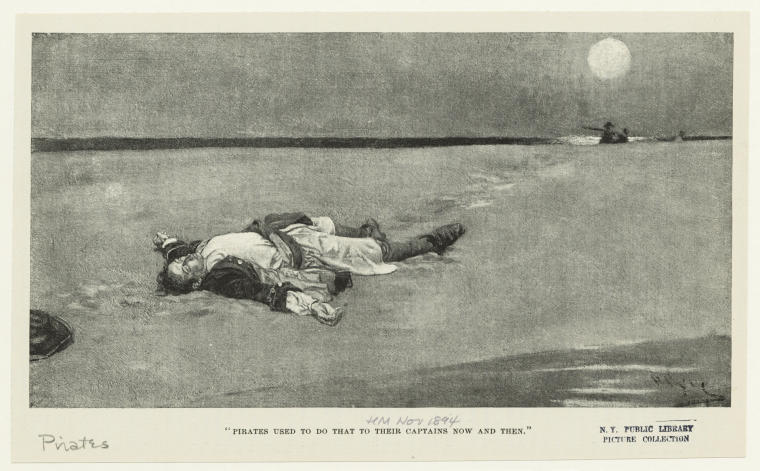
This 1894 drawing by Howard Pyle has the caption, “Pirates used to do that to their captains now and again” (New York Public Library)
Where the Atlantic and Indian Oceans converge off the Cape of Good Hope, there are frequently giant waves and confused seas, along with sometimes powerful, gusty winds. For fear of possible cannon shots from Dutch shore batteries, it was always a good idea for pirates and other foreigners to sail at least three miles off the coast at that spot. Tew managed to sail safely back to Newport, but he helplessly watched Mayes’s sloop Liberty being overwhelmed by an unexpected squall amid the waves off Cape Town and then sink. In the face of dangerous waves, there was no sense in taking an extreme risk by changing course to sail over to where she sank. Tew aboard Amity was sadly convinced that there had been no survivors, so when he arrived at Newport he made no effort to carry out the rest of the plan to try to bring Americans to settle in Libertatia. However, Mayes and a few crewmen had assembled some floating wreckage and safely managed to dodge the numerous sharks to get ashore among the penguins near Cape Town. From there they eventually returned to Libertatia.
Tew, who sold Amity, was quite happy to remain in Newport, but his former crewmen were not. Having spent their treasure, they begged him to take them on one last voyage. He reluctantly bought a newly-built Rhode Island 12-gun sloop, giving her the same lucky name of Amity, and secured a new commission at great expense from Governor Cranston; Cranston’s greed was possibly exceeded only by that of Governor Benjamin Fletcher of New York from 1695 to 1698.
When they reached the Indian Ocean, instead of making first for Libertatia, they fell in with a pirate fleet led by Henry “Long Ben” Every (or Avory who was actually using an alias of Benjamin Bridgeman during the two years when he was a pirate). Every had a particularly vicious reputation. He commanded an unusually large ship for a pirate, the 46-gun two-decker cruiser Fancy, fitted out by Bristol merchants to be the English privateer Charles II. She was under contract to the Spanish, to carry a crew of up to 350 men and intended to attack French interlopers along the Spanish American coasts. Pirates were notoriously fractious and disobedient, which meant that the large crew needed to operate such a large ship would normally be unmanageable, but not apparently in this case. One of the well-known portraits of Every shows him standing with an accurate depiction of the ship Fancy in the background.
When Fancy’s original captain was repeatedly drunk ashore while they were at anchor at Coruna, Spain, Every, who had been First Mate, took over the ship with the acclamation of the crew, and sailed off to be pirates in Madagascar. Their plan in September 1695 was to gather as many other pirate ships as they could assemble and attack a rich Arab convoy of 25 ships returning to India from the Hajj. The pirate fleet included Every’s Fancy, Richard Want’s ship Dolphin (too slow to reach the battle), Joseph Faro’s (or Farrell’s) ship Portsmouth Adventure, Thomas Wake’s ship Susannah (too slow to reach the battle), Tew’s Amity II, and Mayes’s 16-gun Rhode Island brig Pearl. They attacked the guard-ship Fath Mahmamadi first, which Every managed to capture with its hefty treasure, but a stray cannon shot laid open Tew’s abdomen, killing him; his dispirited crew withdrew from the battle at that time, with Amity II otherwise mostly unscathed.
Every went on to capture the 62-gun Arab treasure ship Gung-i-Sawai (the pirates, who had trouble with foreign languages, called her “Gunsway”) with her armed crew of 400, and 600 passengers and ten times the amount of treasure carried by the other ship. The two-hour battle cost many lives on both sides. Many of the wealthy Muslim women jumped over the sides to their deaths in the sea rather than submit to the barbarous whims of the pirates. The owners of the ship complained to the English East India Company, who relayed the complaints to authorities back in England. They put a steep price on Every’s head. Every himself managed to hide his identity and return quietly to England, one of the few pirates to die in his own bed (in his case, in Scotland), but many of his men were purposefully hunted down all over the world (in the Indian Ocean, the Caribbean, North America, Europe, and the British Isles) in the next few years and hanged. The famous Scottish pirate William Kidd, who had temporarily turned pirate-hunter for the English government (actually for Lord Bellomont in New England), was specifically sent to the Indian Ocean in order to apprehend Tew, although it turned out that Tew had already been killed before Kidd arrived. Mayes was also on Kidd’s list, but he never found him.
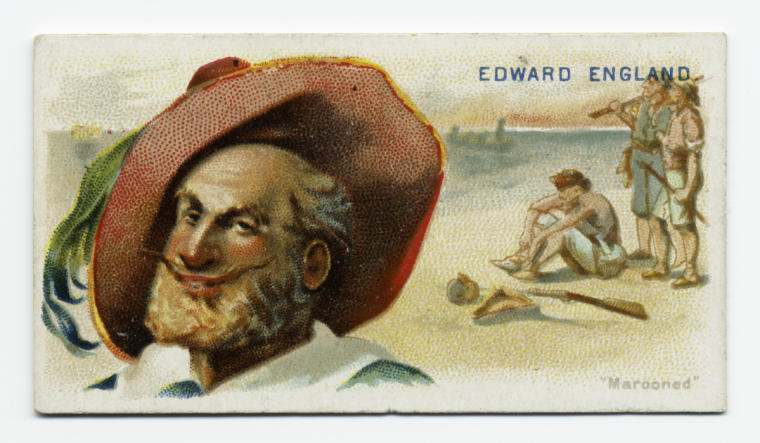
Like William Mayes, the pirate Edward England was not a thug. The caption to this Allen and Ginter cigarette card reads, “Ned England was a pirate of a different sort from many of those whose lives we have had occasion to chronicle. He was a rollicking, good natured fellow who would have been perfectly contented with a moderate amount of plunder, and less villainous deeds; but he was often over-ruled by his wicked associates. Ned began life as mate of a Jamaica sloop; was taken by pirates; and, not long after, himself appeared as master of a piratical sloop.” (New York Public Library).
It should be mentioned that Kidd himself briefly turned pirate again in the Indian Ocean, and although after this he had resolved to live a clean life, word of his recent piratical exploits reached Boston and London ahead of him, so he was arrested in Boston, taken to London, tried, and hanged in 1701. At the time of his execution, a song of no literary merit was written in London about him, “My name is Captain Kidd, as I sailed, as I sailed,” but its rather modal tune was so good that it was re-used in the nineteenth century for a hymn that appears in many Christian hymnals today, “What wondrous love is this, o my soul, o my soul.” This is one of very few authentic period songs about pirates.
Before sailing away to the Bahamas in late 1695, Every stopped briefly at Libertatia and gave Mayes a generous contribution of gold towards buying supplies for the republic. A well-known woodcut shows Every being shaded by an umbrella held by a black servant, with presumably the main fort of Libertatia in the background. Amity II also sailed in after the battle to tell the citizens the sad news about Tew.
Mayes, who was sorry to have lost his friend Tew on his last and fatal voyage to the Indian Ocean, commanded the ship Charming Mary at Madagascar in 1699, but was back in New York by 1700.
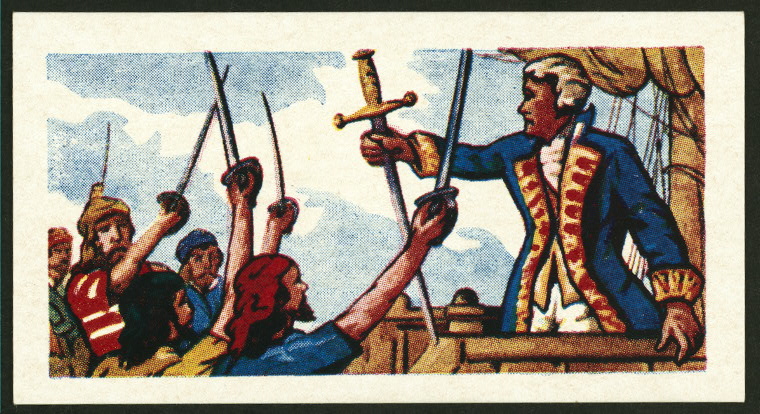
William Mayes piratical exploits in founding Libertatia were celebrated in a French cigarette card. He was called “Lieutenant Mission” and was dressed in a French officer’s uniform. The French called the colony Libertania. (New York Public Library)
Mayes decided he had spent enough time at Libertatia, so in 1702 he quietly returned to Newport, where he joined the family business and operated the White Horse Tavern at the corner of Farewell and Marlborough Streets (Marlborough Street had a different name at that time until it was renamed after the Duke of Marlborough’s four great victories over the French in 1704, 1706, 1708, and 1709). The White Horse Tavern still stands, founded in 1673 in a building first constructed as a house two decades earlier, the oldest still-operating tavern in North America. Mayes is said to have died in September 1718, the last of all the well-known pirates of Libertatia. The White Horse Tavern was then taken over by his sister, Mary Nichols.
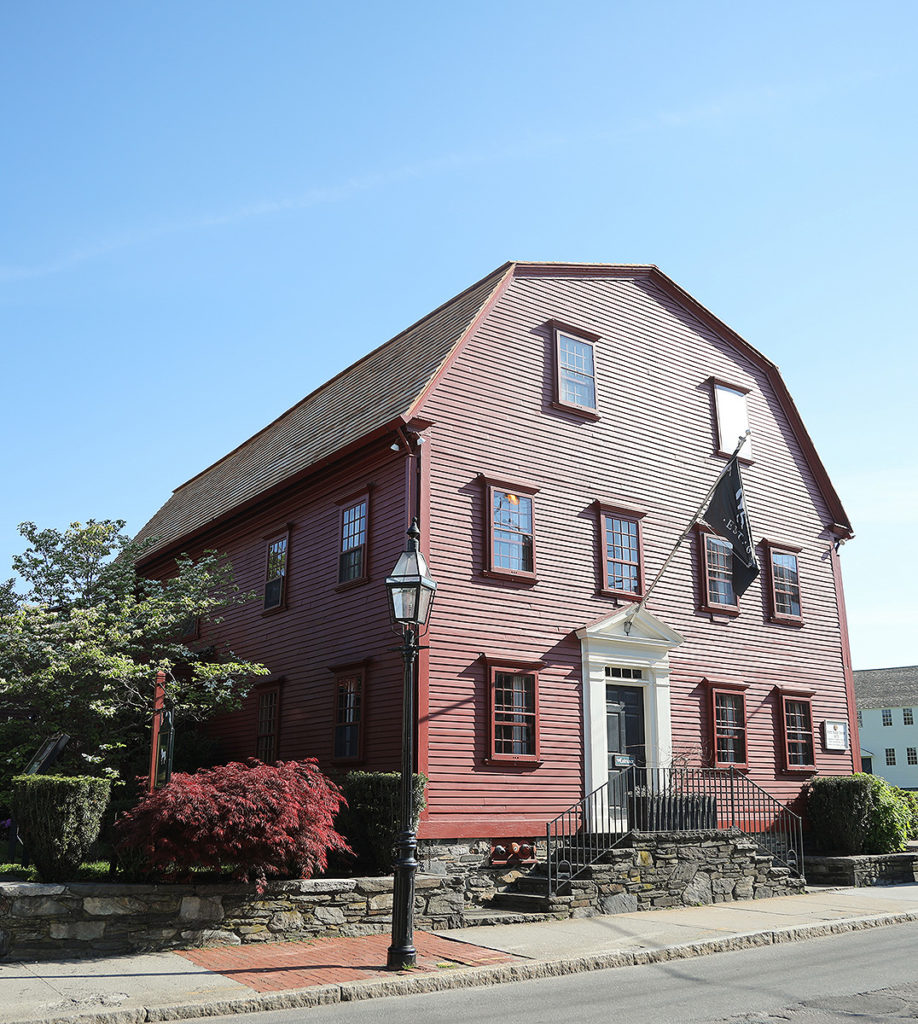
This is the White Horse Tavern today, located at the corner of Marlborough and Farewell Streets, the oldest continuous operating tavern in the country. Parts of the building date from 1673 and it was originally the home of the pirate William Mayes. (White Horse Tavern website)
Libertatia apparently continued in operation until about 1717. The celebrated circumnavigator Captain Woodes Rogers, who later cleaned up piracy in the Bahamas as governor there, spent from 1713 to 1715 in Madagascar, offering all the pirates who had gone native there full royal pardons from Queen Anne if they returned peaceably to Britain or her colonies, and many of them agreed to do so. Whether the republic went out of business because of the loss of so many citizens returning to England, or whether it was subjected to further attacks by fierce tribes from the interior, or both, remains unknown.
Nearly all the information about Libertatia comes from one 1724 book, A General History of the Pyrates (one edition gives the title as A General History of the Robberies and Murders of the most notorious Pyrates) by “Captain Charles Johnson.” Johnson is otherwise unknown, and most scholars believe it was a pseudonym for the great writer of both fact and fiction, Daniel Defoe (1660-1731), the author of Robinson Crusoe (published 1719). Many commentators have stated that Defoe invented Libertatia out of thin air, placing a piece of fiction in an otherwise mostly factual book, but if he did, how would that account for pirates in the Bahamas before 1724 mentioning Libertatia in some of their documents? No doubt, they had heard about it from Every and other pirates who had visited there.
Although from time to time various modern expeditions have travelled to the area to search for the location of the republic, archaeologists have so far discovered no trace of Libertatia and its buildings. Since lush jungle covers much of the likely location it would be difficult to spot now, over three centuries later.
[Banner Image: William Mayes piratical exploits were celebrated in a French cigarette card. He was called “Lieutenant Mission.” “Mayes” is short for “May’s son,” which evolved into “Mason.” “Misson” is obviously the French mispronunciation of Mason (New York Public Library)]

